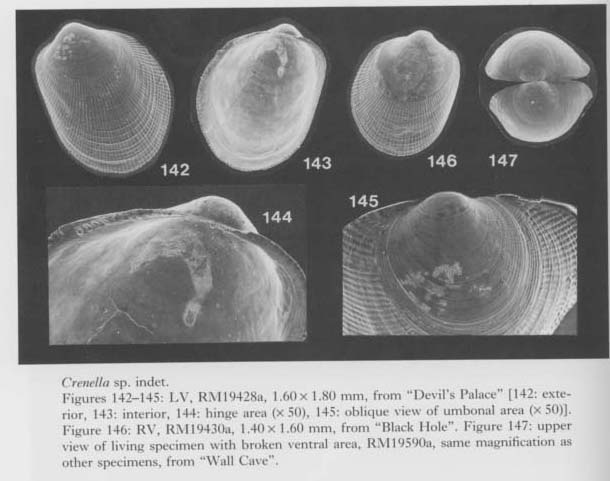Subfamily Crenellinae Gray, 1840
Genus Crenella Brown, 1827
Crenella sp. indet.
Figures 142-147

A few minute specimens of Crenella have been found from the bottom sediments of "Devil's Palace" (RM19428), "Fool's Palace" (RM19429), "Wall Cave" (RM19590, partly living on ceiling) and "Black Hole" (RM19430) of Shimoji Islet, and "Shodokutsu" (RM19431) of Ie Islet.
The shell is smaller than 2.0 mm in height, subovate, strongly convex, and charac-terized by a nearly smooth umbonal area and numerous fine divergent riblets of later dissoconch, about a dozen granular denticles along the postero-dorsal margin, and finely crenulated inner valve margin. The Pd I is very large, D-shaped, about 220 µm in maximum diameter; Pd II absent.
These specimens seem to belong to an undescribed species, but the material is still insufficient to estimate the adult size. A living specimen was found attached to the ceiling of a cave, but it is still uncertain that the present species is indigenous to cryptic environments.
Subfamily Dacrydiinae Ockelmann, 1983
Genus Dacrydium Torell, 1859
Dacrydium is a small-sized mytilacean genus, characterized by thin, hyaline and non-nacreous shell, a barely reduced anterior adductor and persistent denticles de-rived from provinculum that persist until the latest growth stage. It has been known mainly from bathyal and abyssal bottoms of the Pacific, Atlantic, Indian and Antarctic oceans (Knudsen, 1970; Okutani, 1975; Bernard, 1978; Ockelmann, 1983; Poutiers, 1989; Dell, 1990; etc.), though a few species are known from shallower waters of the East Pacific (Galapagos and California) and the Mediterranean. The abundant occurrence of a representative species of Dacrydium in sublittoral caves of a subtropical region is remarkable.
As pointed out by Ockelmann (1983), the hinge structure and non-nacreous shell homologous with nepioconch of other mytilids may be regarded as paedomorphic features. According to Le Pennec (1980) and Waller (1990), in many species of the Isofilibranchia initial fibrous ligament characterized by a primary subumbonal ligament pit appears only in the early growth stage immediately after the metamorphosis and becomes soon inactive by the development of posterior secondary ligament char-acterized by pseudonymphae. The initial ligament is active and persistent throughout growth in Dacrydium species, though incipient pseudonymphae may be observed in a few species.